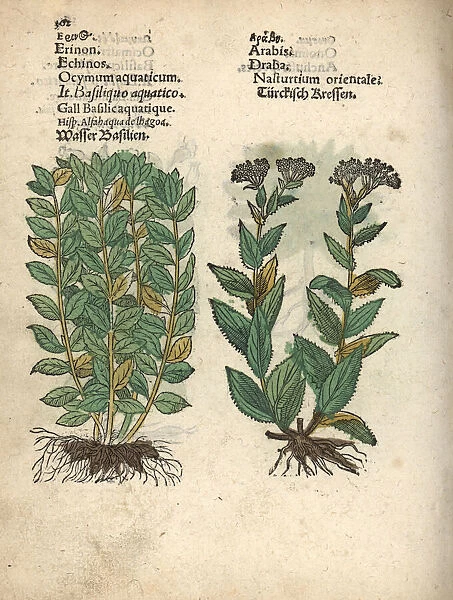Home > Mary Evans Prints Online > New Images August 2021
Basil, Ocimum basilicum, and whitetop or hoary
![]()

Wall Art and Photo Gifts from Mary Evans Picture Library
Basil, Ocimum basilicum, and whitetop or hoary
Basil, Ocimum basilicum, and whitetop or hoary cress, Lepidium draba. Handcoloured woodblock engraving of a botanical illustration from Adam Lonicers Krauterbuch, or Herbal, Frankfurt, 1557. This from a 17th century pirate edition or atlas of illustrations only, with captions in Latin, Greek, French, Italian, German, and in English manuscript
Mary Evans Picture Library makes available wonderful images created for people to enjoy over the centuries
Media ID 23192372
© Florilegius/Mary Evans
Adam Aquatica Arabis Basil Basilicum Cress Herb Herbal Hoary Krauterbuch Lepidium Lonicer Nasturtium Ocimum Orientale Pirate Woodblock Woodcut Draba
EDITORS COMMENTS
This exquisite handcoloured woodblock engraving is taken from the botanical masterpiece, "Krauterbuch" or "Herbal" by Adam Lonicer, published in Frankfurt in 1557. The illustration depicts two distinct plants: Basil, Ocimum basilicum, and Whitetop or Hoary Cress, Lepidium draba. Basil, also known as Ocimum basilicum, is a fragrant herb with numerous varieties, including sweet basil and holy basil. It is native to tropical regions in Asia, Africa, and Europe, and has been cultivated for its aromatic leaves and medicinal properties for over 5,000 years. In the Middle Ages, basil was believed to have protective powers and was often used to ward off evil spirits. Today, it is widely used in cooking for its pungent, sweet, and slightly peppery flavor. The second plant depicted in the engraving is Whitetop or Hoary Cress, Lepidium draba. This small, herbaceous plant is native to Europe, Asia, and the Mediterranean. It is also known by several other common names, including Arabis, Nasturtium arabesque, and Hoary Alyssum. The plant is characterized by its white, four-petaled flowers and delicate, lobed leaves. Whitetop Cress was used in traditional medicine for its diuretic and expectorant properties. This botanical illustration is a beautiful example of the intricate detail and artistry of the 16th century. The engraving is adorned with captions in Latin, Greek, French, Italian, German, and English manuscript, reflecting the international reach of botanical knowledge during this period. The illustration is also a testament to the importance of botany in the early modern world, as plants were not only used for medicinal purposes but also for culinary, ornamental, and spiritual reasons. This pirate edition or atlas of illustrations only further highlights the enduring appeal and value of these botanical masterpieces.
MADE IN AUSTRALIA
Safe Shipping with 30 Day Money Back Guarantee
FREE PERSONALISATION*
We are proud to offer a range of customisation features including Personalised Captions, Color Filters and Picture Zoom Tools
SECURE PAYMENTS
We happily accept a wide range of payment options so you can pay for the things you need in the way that is most convenient for you
* Options may vary by product and licensing agreement. Zoomed Pictures can be adjusted in the Cart.




